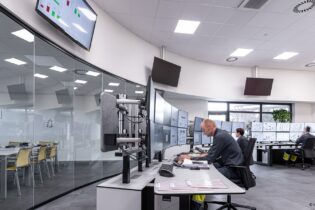Datacenter office ‘Christelijke Mutualiteit’
Brussel, Belgium, Europe
| Total technical installations cost: | € 340.464,00 VAT excluded (cooling) + € 132.650,00 VAT excluded (UPS) |
| Tier design level | 3 |
Project description cooling:
The live main data center of the health insurance company ‘Christelijke Mutualiteit’ supporting all national officers and pharmacists was in direct need to be updated. The existing cooling production was end of life and consuming too much electricity. Therefor a new more performant cooling production and emission system was put in place in a tier 3 configuration (ensures that replacement and maintenance of equipment can take place without downtime).
The partial simultaneous reorganization of active equipment and the presence of some high-density areas was a challenge to optimize airflows from the crahs (Computer Room Air Handler). In addition, special attention was paid to acoustics due to the presence of an adjacent hospital.
Due to lack of space in this very urban area, a phased replacement was put in place so redundancy was maintained during construction works.
Not only were chillers more performant but the client chose to implement free chilling as well. The new N+1 configuration (an additional component added to support a single failure or required maintenance on a component) resulted in a 25% decrease of electricity consumption for cooling.
Project description UPS:
Understanding the high-energy demand required for the efficient operation of a data center, the sustainable aspect of this project was of paramount importance to the client, setting yield criteria at the highest in existence.
In the search for a decent replacement, we opted for a Lion battery powered ups equipped with the latest technological features. Depending on the operating mode, this can achieve a return of more than 99%, which is the setting mode the customer wanted to achieve. This is a first in Belgium regarding the installation of a Lion ups.
Together the footprint for these 2 new UPS is about a third of the previously required space, with a capacity of 320KVA. The high efficiency of this device ensures that the cooling necessary for the operation of the old UPS generation completely disappears, thus creating additional energy savings.












